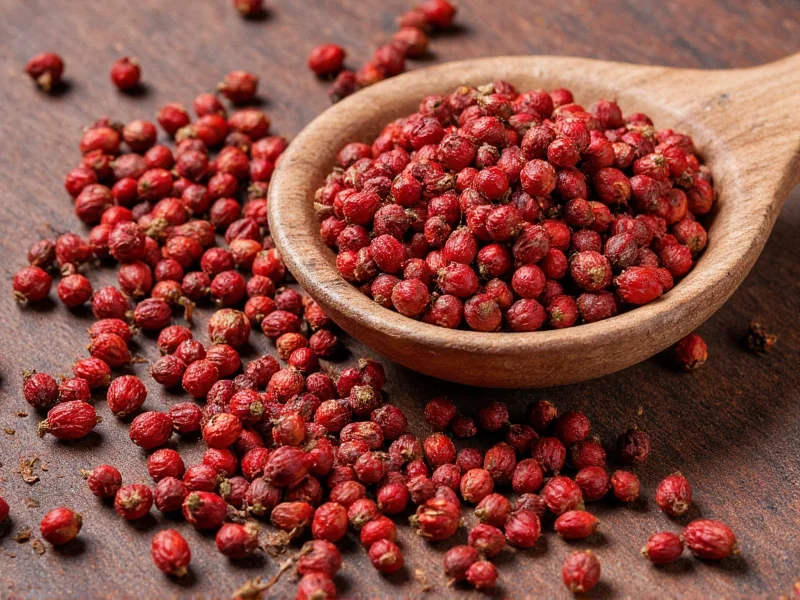Understanding what makes Sichuan peppercorn unique is essential when seeking substitutes. Unlike regular black pepper, Sichuan peppercorn (hua jiao) delivers a distinctive tingling, numbing sensation called ma alongside its citrusy, floral heat. This characteristic comes from hydroxy-alpha sanshool, a compound not found in other peppers. When you're searching for the best substitute for Sichuan peppercorn in recipes, you're essentially trying to replicate either the numbing sensation, the flavor profile, or both—depending on your dish.
Why Finding a Perfect Sichuan Peppercorn Alternative Is Challenging
Sichuan peppercorn isn't actually a true pepper but the dried berry of the Zanthoxylum plant. Its unique sensory experience combines:
- A citrusy, floral aroma with hints of lavender and sandalwood
- A tingling, numbing sensation that affects the tongue and lips
- Subtle heat that builds gradually
Most substitutes can only approximate one or two of these elements, which is why understanding your specific recipe needs is crucial when selecting a Sichuan peppercorn replacement.
Top Substitutes for Sichuan Peppercorn
Sansho Pepper: The Closest Flavor Match
Japanese sansho pepper comes from a related Zanthoxylum species and offers the most similar numbing sensation. While slightly less intense than authentic Sichuan peppercorn, it provides the characteristic ma effect. Use a 1:1 substitution ratio, but note that sansho has a more pronounced citrus note.
Tellicherry Black Pepper + Lemon Zest: Best Overall Alternative
For the closest approximation when sansho isn't available, combine freshly ground Tellicherry black pepper (known for its complex flavor) with lemon or orange zest. The Tellicherry provides depth while the citrus mimics Sichuan peppercorn's floral notes. Use ½ teaspoon black pepper plus ¼ teaspoon zest for every 1 teaspoon of Sichuan peppercorn required.
Black Pepper + Chili Flakes: For Spicy Element
When you need the heat without the numbing sensation (common in Western adaptations), use a blend of high-quality black pepper and red chili flakes. This works well for dishes where the numbing effect isn't essential. Try ¾ teaspoon black pepper plus ¼ teaspoon chili flakes per teaspoon of Sichuan peppercorn.
Commercial Sichuan Peppercorn Blends
Many specialty spice companies offer pre-mixed Sichuan peppercorn substitutes that combine black pepper, coriander, fennel, and other spices to approximate the complex flavor profile. These provide convenience but vary in quality—check ingredient lists for artificial additives.
| Substitute | Ratio | Best For | Limitations |
|---|---|---|---|
| Sansho pepper | 1:1 | Dishes requiring authentic numbing sensation | Less floral, more citrus-forward flavor |
| Tellicherry pepper + citrus zest | ½ tsp pepper + ¼ tsp zest per tsp | General cooking, stir-fries, marinades | No numbing effect, requires two ingredients |
| Black pepper + chili flakes | ¾ tsp pepper + ¼ tsp flakes per tsp | Dishes where heat matters more than numbing | Lacks floral notes, no tingling sensation |
| Timut pepper | 1:1 | Nepalese or Himalayan recipes | More grapefruit-like, less numbing |
Regional Variations Worth Exploring
Several regional alternatives offer unique takes on the Sichuan peppercorn experience:
- Timut pepper from Nepal has a more intense grapefruit-citrus profile with moderate numbing
- Indonesian Sichuan pepper (andaliman) provides similar numbing with a distinct pine-like note
- Prickly ash from North America offers mild numbing but lacks the floral complexity
When experimenting with these alternatives for Sichuan peppercorn in cooking, start with smaller quantities as their potency varies significantly from authentic Chinese varieties.
Practical Tips for Using Substitutes Successfully
Understanding how to replace Sichuan peppercorn in cooking requires attention to timing and technique:
- Add substitutes later in cooking than you would authentic Sichuan peppercorn, as their volatile compounds dissipate faster
- Toast whole substitutes briefly before grinding to enhance flavor complexity
- For dry rubs, increase substitute quantities by 25% to compensate for less intense aroma
- In soups and stews, add substitutes during the last 5-10 minutes of cooking
- When making chili oil, infuse substitutes for no more than 3 minutes to prevent bitterness
Where to Source Authentic Sichuan Peppercorn
While substitutes serve well in a pinch, authentic Sichuan peppercorn elevates dishes significantly. Look for:
- Red Sichuan peppercorn (most common, stronger numbing)
- Green Sichuan peppercorn (more floral, less numbing)
- Qingke peppercorn (premium variety with intense aroma)
Reputable online retailers specializing in Chinese ingredients typically offer fresher stocks than general grocery stores. When purchasing, check for vibrant color and a strong citrus aroma—dull, musty-smelling peppercorns have lost their essential oils.
When Substitutes Work Best (and When They Don't)
Not all dishes tolerate substitutions equally. Understanding what spice can be used instead of Sichuan peppercorn depends on the recipe:
- Works well: Stir-fries, dry-pot dishes, marinades, and sauces where Sichuan peppercorn isn't the star flavor
- Moderate success: Mapo tofu (substitutes work but alter the authentic experience)
- Poor substitutes: Dishes where the numbing sensation is central, like Sichuan hot pot or water煮 fish
For authentic Sichuan peppercorn substitute without numbing effect, focus on replicating the citrus-floral notes rather than the tingling sensation.











 浙公网安备
33010002000092号
浙公网安备
33010002000092号 浙B2-20120091-4
浙B2-20120091-4